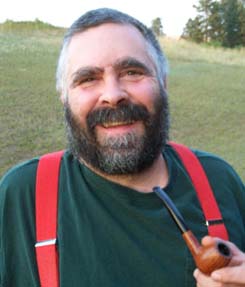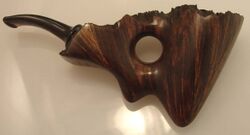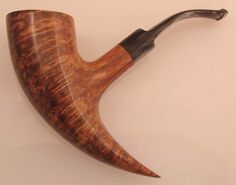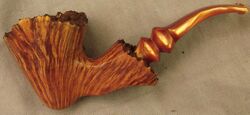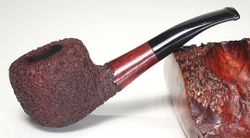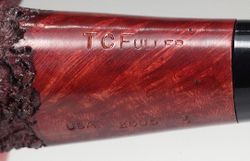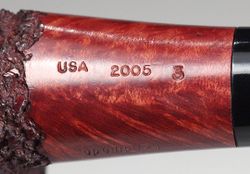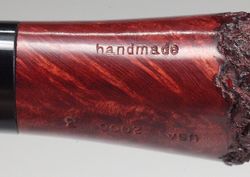TC Fuller Pipes
I was building a deck on our house in Alaska. One rare, calm, sunny day, the thought popped into my head that it would be pleasant to sit on the deck on a day like this and smoke a pipe. I’d smoked a pipe during my junior high years, losing interest sometime my freshman year of high school. I’m dating myself here; when I was in junior high, youngsters could still buy tobacco. I started with a corncob and cherry blend, subsequently graduating to a Dr. Grabow bent and green Sail.
After I rolled up that fateful September afternoon, I went on the net to see what there was about pipes, and spent all evening and all the next rainy day clicking on links from the pipes web page, reading FAQs and visiting online tobaconnists and pipe maker’s sites. I ordered two pipe making kits, along with stain, carnuba wax, and tripoli.
The next time I went to town I scoured all the stores and gas stations looking for a pipe and tobacco. I met with failure. When I returned home, my wife suggested I take a look on eBay. She has been an eBayer for years, and, come to find out, had money in her Paypal account. I bid on several pipes, and ordered some tabac from an online tobacconist.
Within a couple of weeks, I had an Ebay monkey on my back. I ordered two more kits. I used my jig saw, random orbital sander, and a Dremel tool to shape the pipe kits. Within a month or so, as I learned more, I began coveting the more expensive pipes. After winning several auctions at well over a hundred bucks a pop, I realized that this couldn’t continue, and that I’d better learn to make my own. I bought a small bench drill press, a tenon turning tool and the various pipe-making drill bits, as well as a bench bandsaw and combination sander, which worked an order of magnitude better than the hand tools. I started buying briar and stems, both on Ebay and from the several purveyors of briar and stems.
When I wasn’t making pipes, I was trying to finish our house so we could sell it prepatory to moving to Idaho, where my wife had been accepted into the University of Idaho school of law for an August 2003 matriculation. Finally, along towards spring, I had to put the pipe making on hold and start packing. The accumulation of sawdust in the little room I’d been using as a shop was impressive. As a matter of fact, there was briar dust all through the house, as I didn’t have a shop vac hooked up to the sander, and had been doing the final sanding and staining at the dinning room table.
To make a long story short, we moved, bought a house with a big garage, and finally, in December of 2003, I got a shop established in the garage. Having sold my bench tools so we wouldn’t have to move them, I upgraded to a much bigger drill press and bandsaw, bought another combinaton sander, a shop vac, and a lathe, which I’ve yet to use for pipe making, but on which I am having a ball turning bowls.
I have been either in the woods, or working with wood, all my life; hiking, ship building, logging, residential and commercial construction. I have a fondness for beautiful wood. Briar is gorgeous. There’s a sense of adventurous anticipation with each block as I square it up on the disc sander, revealing the grain prepatory to seeing how it will best lend itself to a pipe. After drilling the mortise and tobacco hole, and boring the tobacco chamber, the eager anticiaption becomes admixt with dread that the rough cutting-to-shape on the bandsaw will reveal cavernous sandpits, sandlines, or checking. The pipe's final shape often differs considerably from my orignal intent as I try to sand away defects. Sometimes a stummel is beyond salvage. I read somewhere, it might have been in Preben Holm’s autobiography, that only something like 3-5% of briar blocks are perfect, the rest picking up sand and pebbles and wormholes as the burl grows, or checking while drying.
A pipe is s simple piece of gear; two intersecting holes in a piece of wood, clay, glass, or rock, but the variations on the basic theme are infinite, or nearly so. The staggering number of possible shapes, along with the beauty and variety of the briar itself, is awesome. Making a pipe, despite the interminable hand sanding, is highly satisfying, especially when the grain, the stain, and the shape all come together, resulting in a pipe of which somebody might say: “That’s a nice pipe”. Needless to say, beauty is in the eye of the beholder, one man’s mead is another man’s poison, every Jack will find his Jane, and so on. There is no accounting for taste. I hope that each of my pipes will strike somebody’s fancy. In the meantime, I’m having fun making them, admiring the grain and playing with differant shapes and stain combinations. In the immortal words of Dr. Suess: "It’s fun to have fun, but you have to know how."
Gallery
- Example and details, courtesy Doug Valitchka
Articles
Contact Information
Sorry, the contact information we had is no longer accurate, and we have not been able to find current information. If you have contact information, please add it here, or send it to sethile.pipes@gmail.com and we can add it for you...
